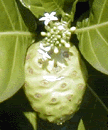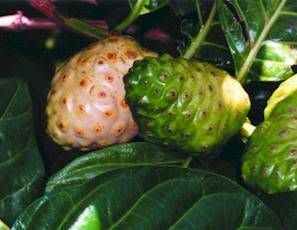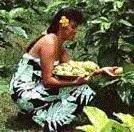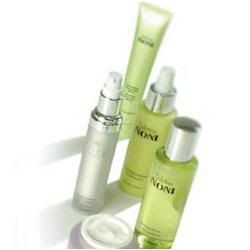|
tvbuonsj
member
ID 22605
04/13/2007

|
Trái Nhàu (vị thuốc quý)













Tahiti Traders' Noni Juice, known botanically as Morinda Citrifolia, is a native of the lush and unspoiled islands of Tahiti. For at least 2,000 years, the island people have used Noni to promote their health. Recently science has demonstrated that the Polynesians were right when they boasted of the unique health benefits of their precious Noni Juice.
The Tahiti Trader Company was established to manufacture and sell the finest Noni Juice products for the natural food and mass consumer markets.
Noni fruit from the Morinda Citrifolia tree is a true nutraceutical food, with a colorful history. Often compared to Aloe Vera for its nutritive properties Noni is quickly becoming one of the most powerful (virtually non-fortified) nutritional drinks known.
The Tahiti Trader Brands Company has been the leader in the research associated with the manufacturing of Noni juice. Currently Tahiti Trader is involved in scientific research to support Noni's nutritional efficacy for consumers who enjoy drinking Noni juice for its health benefits.
Tahiti Trader's proprietary manufacturing process ensures the most bio-available nutrition from the Noni fruit. Combining ancient traditional recipes with the latest technical science developed the formulation. Tahiti Trader's Noni juice is the finest product available today, with the quality and great taste consumers demand and deserve.
The Noni Story
Copyright © 2001 Tropical Functional Laboratories
Introduction
Today you can begin to rejuvenate yourself with the miracle of Noni. Noni has been used for thousands of years; the fruit from the Noni (Morinda Citrifolia) plant is now touted by mainstream physicians, biochemists, herbalists, and medical researchers as a miracle substance for the human body.
Morinda Citrifolia, known as the Indian mulberry it is most commonly known today by the name ancient Hawaiian healers gave it, which is simply Noni.
Brief History
Historically, Morinda Citrifolia was used for the
Traditional healers, for medicinal use, employ every part of the Noni plant: leaves, roots, bark, seeds, flowers; The bark has strong astringent properties. Noni fruit, the most prized part of the plant, has numerous applications, including many that are listed above.
Noni is also very nutritious. In some ancient cultures Noni was a dietary staple and in others only consumed as a source for nourishment in times of famine. The oldest references to Noni date back tens of centuries to India's ancient Sanskrit writings that cite the use of the Och plant in Ayurvedic medicine. Historians believe that Noni originated in Southeast Asia, and that during an ancient migration to colonize new lands, it was brought to Micronesia and the Polynesia. Polynesia has a rich heritage, and knowledge about Noni's uses was handed down from generation to generation. Scientific literature about Noni is more substantial from this region of the world than from India or any other region.
Noni horticulture history
The Noni plant is an evergreen that can range from a small bush to a tree 30 feet tall. The Noni bush produces a lovely, fragrant white flower that blooms year round. Noni fruit has a lumpy texture, very high in fiber, looks similar to a medium size potato, and has a rancid taste and smell when ripened.
The Noni fruit is covered with red-brownish pits that contain seeds. Each seed has an attached air sac that allows it to float for a month in the ocean. It is thought that this is how Noni may have been transported to various countries centuries ago.
Polynesian healers and historians insist, that, the Noni plant was considered sacred and brought intentionally to the islands primarily because of its properties. Noni is also valued of its nutritional properties, and of its use as a dye.
The ocean-going Polynesians made voyages from island to island in their canoes to colonize new lands. They brought with them only the essentials to survive: food, clothing, tools, and medicinal plants which included the sacred Noni plant.
Noni's many wonderful uses
Traditionally, the Noni plant was highly valued. In past times it was often difficult to get people, especially children, to take Noni juice because of its rancid smell and taste.
It's a fact, in the early and mid 1900's Noni was very unpopular in many Polynesian communities because of its unpleasant smell, and many trees were cut down to clear residential areas of the Noni's foul odor. Prior to the 1900's, Christian missionaries who came to Polynesia banned Huna, the term for Polynesian natural healing, and interest in Noni somewhat diminished.
For thousands of years, people have used food, herbs, fasting, colon cleansing, and other natural methods to strengthen the immune system and to prevent and cure disease. According to the World Health Organization figures, herbal medicine is still the most widely practiced form of medicine in the world today.
Today Noni fruit is a highly prized commodity just as it was in ancient times
Modern methods of extracting and preparing precious Noni Juice eliminate much of the unpleasant smell and taste without compromising beneficial properties. Noni juice is best when taken in liquid or juice form.
Pharmaceuticals
Drugs used to treat illness and diseases are called pharmaceuticals. Noni contains a variety of beneficial Phytochemicals, some of which are not found in any other known plant. These Phytochemicals work synergistically to enhance biologically the expression of each individual component found in Noni. Researchers think this may account for Noni?s amazing array of benefits to various body systems.
Xeronine, Phytochemical Alkaloid, Essential to Life
Dr. Ralph Heinicke discovered a physiologically active alkaloid, in 1957 that occurs in healthy cells of human body, plants, and animals, and microorganisms. He named this new alkaloid Xeronine. Dr. Heinicke had discovered a precursor (the component form which another component is formed) to Xeronine in 1953. Many years later he realized the importance of his discoveries.
Alkaloids are organic nitrogenous compounds that even in negligible amounts have strong physiological effects in our bodies. The amount of free Xeronine left in the blood is then so minute it is well below normal chemical analytical techniques.
How the body uses Xeronine
The body produces Xeronine in order to use, or activate certain inactive enzymes so they can function properly. Xeronine also regulates and gives structure to proteins, a process essential to life. Insufficient levels of Xeronine in the body can lead to serious health problems.
How Dr. Heinicke Discovers Xeronine
The Dole Pineapple Company hired Dr. Heinicke in the 1950's to produce bromelain from the stems of pineapple plants and to develop markets for this new product. He quickly discovered that the commercial mixture of bromelain showed some strange, unique, and very valuable properties that differed from all previous enzyme preparations.
Dr. Hunter, a gynecologist, was the first to use the enzyme in a medical application. He wanted to use Papain, the enzyme from papayas to clear mucus from the vagina before X-ray. By doing this, he would not confuse mucus with tumors when reading the X-rays. Dr. Heinicke suggested he try bromelain and it worked much better than Papain.
Dr. Hunter makes important medical discovery
Then Dr. Hunter made an important medical discovery. He had a patient who suffered from severe cramping during menstruation and often had to be hospitalized. She came to see him when the onset of her menses was inexplicably late. Suspecting that a tumor was causing the obstruction, he gave her the standard bromelain douche to prepare her for X-ray. Within 30 seconds her menses started and she was pain free. A paper written about this event created a great deal of interest among pharmaceutical companies.
Dole finds applications in medicine
Dole felt the most important applications for bromelain were in medicine. A pharmaceutical company developing a medical treatment for severe menstrual cramps asked Dr. Heinicke to extract and prepare a pure protease (the enzyme that breaks down a protein) from the commercial bromelain enzyme mixture. After the pharmaceutical company received the purified enzyme, they tested the protease activity, found it high, and immediately began formulating samples for extensive testing.
Millions spent on double blind studies
The drug companies were anxious to prove the efficacy of the enzyme, and proceeded to spend millions of dollars on conducting double blind studies, only to find the substance had absolutely no pharmacological activity. In the process of purification, the critical component had been discarded as a contaminant. But what was it? The pharmaceutical giant, Toshiba, Japans largest drug company, spent three more years and three million dollars looking for the component before finally abandoning the project.
Dr. Heinicke discovers proxeronine
In the early 1970?s, through much persistence, Dr. Heinicke found that the active components of the bromelain were Xeronine, the alkaloid he had discovered in 1957, and a precursor to Xeronine, which he named Proxeronine. Most biochemists had overlooked this important plant substance, because Proxeronine does not contain sugars, amino acids, or nucleic acids.
While still at Dole Pineapple, Dr. Heinicke noticed that while the protease content of commercial bromelain remained absolutely constant over twenty year period, the physiological activity of the commercial product decreased dramatically over time. He believed that this change was caused by the loss of certain critical micronutrients from the pineapple soils. The decrease in physiological activity led him to explore other plant sources for the critical ingredients.
Dr. Heinicke isolates proxeronine from Noni's
Dr. Heinicke noticed that clinical claims of efficacy for bromelain and Noni were almost identical, so he used the same techniques on Noni juice that he had used to isolate Xeronine from the pineapple plant. He found that he was able to isolate the proxeronine from the Noni, and yields were excellent. Noni contains negligible amounts of free Xeronine. Dr. Heinicke found that it contains substantial quantities of its precursor, proxeronine. This is the critical ingredient since the body generally has an abundant supply of all other factors required to biosynthesize Xeronine.
Dr. Heinicke stated: "Xeronine is so basic to the functioning of protein, we would die without it. Its absence can cause many kinds of illness."
Amino acids are the building blocks of protein. When we consume a protein food such a meat, fish, or soy based products, the body breaks it down into amino acids, which are arranged into proteins the body needs, such as enzymes for metabolic functions and antibodies that fight infection. Protein makes up our hair, skin, fingernails, and muscles as well as some hormones such as insulin. Protein builds new tissue, repairs damaged tissue, and it transports oxygen and nutrients into the blood. The body?s ability to produce Xeronine is diminished, as we get older. Disease, injury, trauma, and stress can also lower Xeronine in our bodies, creating Xeronine deficiency.
Proteins are essential catalysts for thousands of cellular activities
Proteins are essential catalysts for literally thousands of cellular activities in the body. This can explain why supplementing the diet with Noni juice, which has the potential to raise Xeronine levels and normalize proteins, could initiate such a wide range of physiological responses and alleviate so many unrelated disease conditions.
Noni juice can help increase absorption of amino acids & more!
Noni juice can increase the ability of cells within the body to absorb and utilize nutrients such as amino acids, vitamins, and minerals. The actions of Xeronine can enable larger molecules of digested nutrients to pass through cell membranes, thereby improving digestion.
Noni & Serotinin: The Mood Molecule
According to Dr. Heinicke, this is due specific brain proteins in active receptor sites for endorphins; otherwise known as the well being hormones. Endorphins are a group of peptides with potent analgesic properties. Tryptophan is an example of a critical amino acid that is a precursor to Serotinin. When Tryptophan is readily available, the body can use it if needed to increase serotonin levels.
Serotinin is a hormone that acts as a neurotransmitter. Manufactured by the body, it is found along with its receptor sites in the brain, blood platelets, and lining of the digestive tract. It is also a precursor to a hormone called melatonin, which plays a multiple of life giving roles in the body, including regulating biological rhythms.
Neurotransmitters send messages (electrical impulses) from one nerve cell to another. Serotonin is believed to be more than simply a messenger, because it affects a wide range of mental and physical responses in the body and plays a significant role in activities such as temperature regulation, hunger sensations, sexual behavior, and sleep patterns. Serotonin deficiencies can give rise to a wide range of illnesses, depending on what part to the brain is affected.
Noni makes a difference, used in concert
Noni has many beneficial properties. Noni fruit is rich in vitamin C and selenium, essential nutrients that give our body antioxidant protection. Caprylic and caproic acids are short-chain fatty acids found in Noni fruit that promote digestion. All of these beneficial Nutriceuticals work in concert with Xeronine to make Noni juice a miraculous substance. Not suprisingly there are countless anecdotal reports about the beneficial effects.
Noni and Immune System
Dr. Darryl M. See, M.D., assistant clinical professor of Medicine at the University of California's College of Medicine at Irvine, has published several textbook chapters and over twenty-five peer reviewed journal articles on chronic viral illness and immunological disorders.
Over the last five years, Dr. See has tested more than 400 natural products for safety and immunological enhancement. He found Noni juice to be extraordinary and stated that the particular Noni juice he subjected to vigorous testing in the laboratory was totally nontoxic to cells of the immune system and other cells of the body studied, and that it did not disrupt the function of normal immune system balance.
Discover for yourself why people call Noni an ancient health miracle for modern times.

Alert webmaster - Báo webmaster bài viết vi phạm nội quy
|
 |
|
doanchithuy
member
REF: 156239
04/13/2007
|




 

DCT có làm rượu từ trái nhàu để cho bố DCT uống (trị nhức gân, nhức xương...)
Nhàu chín + đường đem ngâm ...đến khoảng vài tuần đem ra tán nhuyễn trên rây để lấy nước cốt vào chai rồi để vào tủ lạnh. Nghe mùi nhàu là chịu không nổi rồi...vậy mà phải ép bố uống .... hic hic....
Ở miền quê Việt Nam thường trồng cây nhàu trước nhà, cây càng trồng lâu năm càng tốt, đố các bạn tại sao vậy? Hìhì....
|
 |
|
manhbg
member
REF: 156243
04/13/2007
|




 

Đề nghị DCT giải thích kỹ hơn Gân với Xương ở dâu?? nếu ở trên mặt thì có chữa được không vây.???Hê.. hê.
|
 |
|
tvbuonsj
member
REF: 156244
04/13/2007
|




 

Sản phẩm để trị những "vấn đề" trên mặt từ trái Nhàu, như mụn, nám, tàn nhang và khô da ...
(TV không biết có trị được da mặt bị dày hay không ...)

|
 |
|
doanchithuy
member
REF: 156246
04/13/2007
|




 

Bố DCT bị nhức 2 bên đầu gối, nhức buốt... và hay than:
- Thà chặt 2 chân đi chứ để nhức như vầy chịu không nổi!
Người ta chỉ thuốc gì cũng uống... Bây giờ thì không nhức nữa... có lẽ nhờ ông năng tập thể dục.
Còn nhức xương ở mặt thì anh Mạnh tìm thuốc gì nhãn hiệu là KissMe gì đó... uống đi nhe!
|
 |
|
taolao
member
REF: 156251
04/13/2007
|




 

Đa số những cây sống điều có thể làm thuốc. Lúc trước tui lên rừng chơi gặp vài ông dân tộc(người thượng) họ than phiền rằng người Việt mình không biết dùng thuốc Nam mà toàn chơi thuốc Bắc. Qua đó tui học hỏi một ít loại dược thảo từ những thức ăn rau cỏ hàng ngày mà họ hướng dẫn. Tui có áp dụng qua thấy có hiệu quả nhưng phải cần thời gian chứ không như thuốc Tây và Bắc. Đúng, trái nhàu là một loại thuốc quý nhưng không mang lại hiệu quả như các nhà sãn xuất thổi phòng như bóng bóng để lừa gạt dân lành.
|
 |
|
manhbg
member
REF: 156253
04/13/2007
|




 

- Tvbuonsj giải thích thẳng thắn thì manhbg hiểu rồi
+ còn DCT giải thích chân tình thì manhbg chưa hiểu lắm
* cảm ơn cả hai người nhé!! thân!
* tại vì ngại nhầm thuốc thôi mà !khổ lắm !
|
 |
|
panliuan
member
REF: 156320
04/14/2007
|




 

Tôi hoàn toàn đồng ý với anh taolao ông anh của tôi uống nước trái nhàu mấy năm mà không khỏi bịnh đau nhức khớp nên bỏ. Mà chẳng dễ uống gì, hôi đến buồn nôn
|
 |
|
guest
REF: 156322
04/14/2007
|

 

Uhm, nó khai giống mùi nước tiểu của bò lắm.
Mà giá đâu có rẻ đâu, cả triệu đồng một chai.
Nói nó là vị thuốc quý thì thực sự quá đề cao rồi
|
 |
|
doanchithuy
member
REF: 156326
04/14/2007
|




 

Tốt nhất là như bố của DCT , năng tập thể dục, đi bộ nhiều... sẽ trị được bịnh!
|
 |
|
anhcongtam
member
REF: 156431
04/14/2007
|




 

Mình đọc qua tất cả các bài viết của các bạn,nói về trái nhàu
Bạn nào nói cũng có lý đúng của mỗi bạn.Nhưng mình chỉ nói thêm một chút
Bất cứ loại cỏ cây gì,mà mình muốn bào chế ra thuốc nam hay thuốc bắc để uống
đều có công hiệu trị bệnh,nhưng tại sao có người hết bệnh mà lại có người không hết bệnh
tuỳ theo cơ thể và bệnh tình của mỗi người.có một điều rất là quan trọng
đó là người bào chế ra loại thuốc đó có được hoàn chỉnh không
mình mua thuốc có đúng chỗ nơi mình đáng tin cậy không?
cũng có nhiều người nghĩ lầm là chỗ.Thấy họ quảng cáo về loại thuốc đó .và được biết thuốc đó có chứa loại cây hay trái nào đó họ biết
Họ mua cây(trái) đó về tự làm lấy uống.nhưng họ đâu có biết làm như vậy.Uống vào không hết bệnh mà còn bị nặng hơn
Vì họ không biết công thức bào chế.cho nên mới xảy ra như vậy
Có rất nhiều loại cây hay trái,đều có những chất trong đó mình phải cần lọc ra.thì mình mới uống hết bệnh được
Mình nói thí dụ về nghệ,Nghệ rất là công hiệu chữa được nhiều bệnh
Nhiều người tiếc tiền không dám mua về uống.Rồi lấy nghệ tươi hay bột nghệ đem về pha nước uống.
bệnh không hết mà còn nóng trong người và còn gây ra nhiều bệnh khác
sự hiểu biết nho nhỏ của tôi đã trải qua,nay tôi muốn góp ý.nếu có gì chưa đúng,các bạn cứ thẳng thắn xây dựng và chỉ bảo
Tôi xin lắng nghe
Thân ái
|
1
|
|
|
Kí hiệu:
 :
trang cá nhân :
trang cá nhân  :chủ
để đã đăng :chủ
để đã đăng
 :
gởi thư :
gởi thư
 :
thay đổi bài :
thay đổi bài
 :ý kiến :ý kiến |
|
|
|
|
|



